CBSE Class 9 Maths Chapter 11 Important Questions - FREE PDF Download
Vedantu’s CBSE Class 9 Maths Chapter 11 Surface Areas and Volumes explores about 3D shape, and mainly it focuses on the surface areas and volumes of different solids like cubes, cylinders, cones, and spheres. It’s all about understanding how to calculate the area of their surfaces and the space they occupy. By practising important questions, you’ll get a strong grip on key formulas and problem-solving strategies, making it easier to tackle your exams.
CBSE Class 9 Maths Syllabus includes this chapter as an essential part of your learning, preparing you for both theoretical and application-based problems. By focusing on Class 9 Maths Important Questions, you'll be able to strengthen all the maths concepts and improve your confidence for the final exams!
Access Class 9 Maths Chapter 11: Surface Areas and Volumes Important Questions
1 Marks Questions:
1. If the perimeter of one of the faces of a cube is
(a)
(b)
(c)
(d)
Ans: (c)
The perimeter of the one face of cube
Volume of the cube is
2. A cuboid having surface areas of 3 adjacent faces as a, b and c has the volume
(a)
(b)
(c)
(d)
Ans: (b)
Let length, width and height of cuboid be
Considering adjacent faces: AEHD, DHGC and EFGH
Let area of
Also, area of
Area of
Area of
Therefore,
Volume of cuboid is
3. The diameter of a right circular cylinder is
(a)
(b)
(c)
(d)
Ans: (d)
Diameter of Cylinder
Height
Radius
Volume of Cylinder
Volume of right circular cylinder is
4. Each edge of a cube is increased by
(a) 40
(b) 96
(c) 160
(d) 240
Ans: (b) 96
Let the edge of the cube be equal to 'a' units.
Thus, the initial surface area
Now, the edge of the cube increases by
The new edge length
Thus, the final surface area
Percentage change
5. Find the curved (lateral) surface area of each of the following right circular cylinders:
(a)
(b)
(c)
(d) None of these
Ans: (a)
Lateral Surface Area or Curved Surface Area of a Right Circular Cylinder
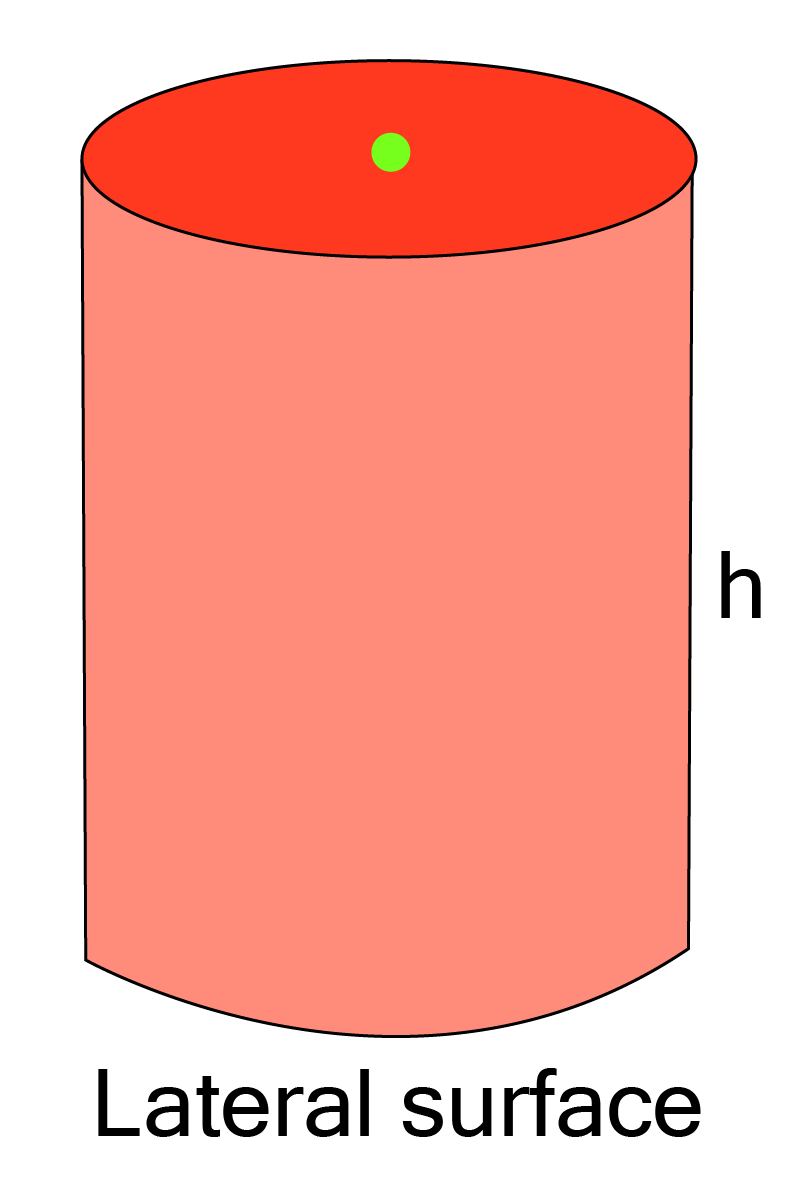
= (Perimeter of the Cross Section) × Height
= 2πrh
6. The radius and height of a right circular cylinder are each increased by
(a)
(b)
(c)
(d)
Ans: (d)
Volume
new radius
So
Volume
7. A well of diameter 8 meters has been dug to the depth of
(a)
(b)
(c)
(d)
Ans: (a)
Volume of the well is
8. The radius of a cylinder is doubled and the height remains the same. The ratio between the volumes of the new cylinder and the original cylinder is
(a) 1: 2
Ans:
The radius of a cylinder is doubled and the height remains the same. (Given)
Radius of original cylinder
Radius of new cylinder
Height remains the same.
We know that,
Volume of new cylinder
Volume of new cylinder
Now
Let ratio of volume be " x ".
Ratio of volume = Volume of new cylinder / Volume of original cylinder
[ Put the values]
The ratio between the volumes of the new cylinder and original cylinder is
9. Length of diagonals of a cube of side a cm is
(i)
(ii)
(iii)
(iv)
Ans: (ii)
Diagonal of
Where is the cube side.
10. Surface area of sphere of diameter
(i)
(ii)
(iii)
(iv)
Ans: (i)
Given Diameter of sphere
surface area of sphere
surface area of sphere
11. Surface area of bowl of radius
(i)
(ii)
(iii)
(iv)
Ans: (iii)
The area of a circle of radius
Thus if the hemisphere is meant to include the base then the surface area is
12. Volume of a sphere whose radius
(i)
(ii)
(iii)
(iv)
Ans: (i)
Volume of sphere
13. The curved surface area of a right circular cylinder of height
(i)
(ii)
(iii)
(iv)
Ans: (ii)
Given, The height of cylinder
and, the curved surface area of cylinder
The curved surface area of cylinder
and
here,
so, the curved surface area of cylinder
so, the diameter of the cylinder is
14. Volume of spherical shell
(i)
(ii)
(iii)
(iv) none of these
Ans: (iii)
Volume of outer sphere
Volume of inner sphere
Total net volume between both the spheres
15. The area of the three adjacent faces of a cuboid are
(i)
(ii)
(iii)
(iv) none of these
Ans: (ii)
Let the 3 dimensions of the cuboid be
Multiplying above three equations,
As,
$
So,
16. A conical tent is
(i) 26
(ii) 27
(iii) 28
(iv) 29
Ans: (i) 26
Height
Radius
Let the slant height of the tent be
Therefore, the slant height of the tent is
17. Volume of hollow cylinder
(i)
(ii)
(iii)
(iv)
Ans: (i)
The formula to calculate the volume of a hollow cylinder is given as,
Volume of hollow cylinder
where, '
18. Diameter of the base of a cone is
(i)
(ii)
(iii)
(iv) none of these
Ans: (ii)
Diameter of the base of the cone is
Curved surface area of a right circular cone of base radius,
Diameter,
Radius,
Slant height,
Curved surface area
Thus, curved surface area of the cone
19. The surface area of a sphere of radius
Ans: Given radius of sphere
surface area of sphere
surface area of sphere
20. The height and the slant height of a cone are
(i)
(ii)
(iii)
(iv) none of these
Ans: (c)
Volume of the cone
Given
slant height
Height of cone
Let radius of cone
Volume of the cone
2 Marks Questions:
1. A plastic box
(i) The area of the sheet required for making the box.
Ans: (i) Given: Length
Area of the sheet required for making the box open at the top
(ii) The cost of sheet for it, if a sheet measuring
Ans: Since, Cost of
cost of
2. The length, breadth and height of a room are
Ans: Given: Length
Area of ceiling
Now cost of white washing for
3. The floor of a rectangular hall has a perimeter
Ans: Given: Perimeter of rectangular wall
Now Area of the four walls of the room
Area of the four walls = Lateral surface area
Hence required height of the hall is
4. The paint in a certain container is sufficient to paint an area equal to
Ans: Given: Length of the brick
Now No. of bricks to be painted
Hence
5. A cubical box has each edge
(i) Which box has the greater lateral surface area and by how much?
Ans: (i) Lateral surface area of a cube
Lateral surface area of a cuboid
(ii) Which box has the smaller total surface area and how much?
(ii) Total surface area of a cube
Total surface area of cuboid
6. Parveen wanted to make a temporary shelter for her car, by making a box-like structure with tarpaulin that covers all the four sides and the top of the car (with the front face as a flap which can be rolled up). Assuming that the stitching margins are very small and therefore negligible, how much tarpaulin would be required to make the shelter of height
Ans: Given: Length of base
Tarpaulin required to make shelter = Surface area of 4 walls + Area of roof
Hence
7. The curved surface area of a right circular cylinder of height

Ans: Given: Height of cylinder
Let radius of base of right circular cylinder
Diameter of the base of the cylinder
8. It is required to make a closed cylindrical tank of height
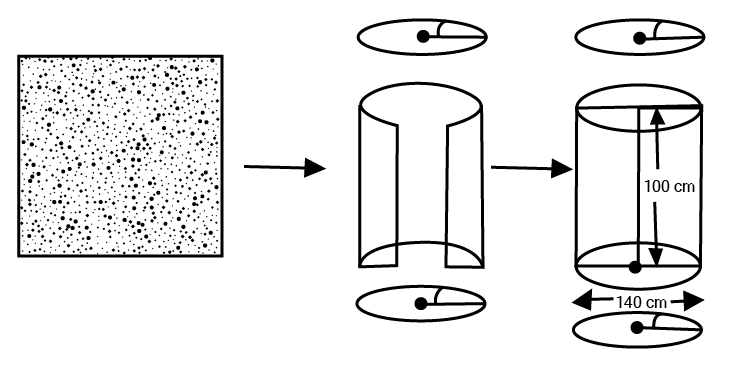
Ans: Given: Diameter
Height of the cylinder
Total surface Area of the cylinder
Hence
9. The diameter of a roller is
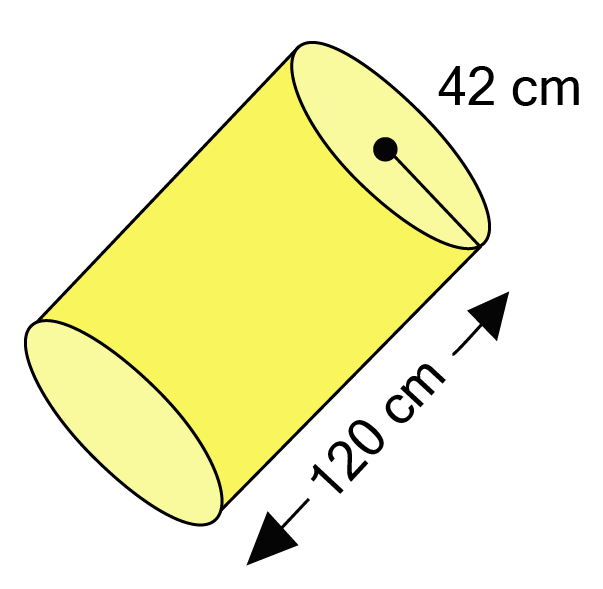
Ans: Diameter of roller
Length (Height) of the roller
Curved surface area of the roller
10. A cylindrical pillar is
Ans: Diameter of pillar =
Height of the pillar
Now, Curved surface area of the pillar
11. Curved surface area of a right circular cylinder is
Ans: Curved surface area of the cylinder
Radius of cylinder
Let height of the cylinder
12. The inner diameter of a circular well is
(i) its inner curved surface area.

Ans: Inner diameter of circular well =
And Depth of the well
(i) Inner surface area of the well
(ii) the cost of plastering this curved surface at the rate of Rs.
Ans: Cost of plastering
Cost of plastering
13. In a hot water heating system, there is a cylindrical piping of length
Ans: The length (height) of the cylindrical pipe
Diameter
Curved surface area of the pipe
14. In the adjoining figure, you see the frame of a lampshade. It is to be covered with a decorative cloth. The frame has a base diameter of
Ans: Height of each of the folding at the top and bottom
Height of the frame
Diameter
Now cloth required for covering the lampshade
=
15. The students of a Vidyalaya were asked to participate in a competition for making and decorating penholders in the shape of a cylinder with a base, using cardboard. Each penholder was to be of radius
Ans: Radius of a cylindrical pen holder
Height of the cylindrical pen holder
Cardboard required for pen holder = CSA of pen holder + Area of circular base
Since Cardboard required for making 1 pen holder
16. Diameter of the base of a cone is
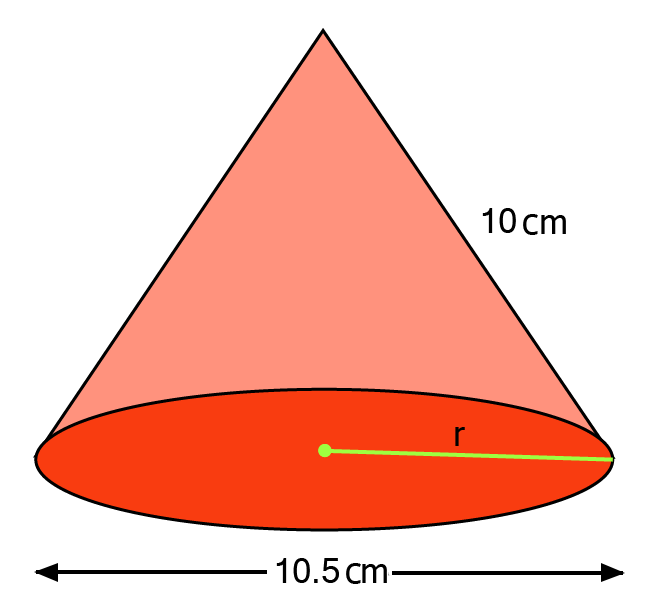
Ans: Diameter
Slant height of cone
Curved surface area of cone
Total surface area of cone
17. Find the total surface area of a cone, if its slant height is

Ans: Slant height of cone
Diameter of cone
Total surface area of cone
18. The slant height and base diameter of a conical tomb are
Ans: Slant height of conical tomb
Curved surface are of tomb
19. A Joker's cap is in the form of a right circular cone of base radius

Ans: Radius of cap
Slant height of the cone
Area of sheet required to make a cap = CSA of cone
20. Find the surface area of a sphere of radius:
(i)
Ans: Radius of sphere
Surface area of sphere
(ii)
Ans: Radius of sphere
Surface area of sphere
(iii)
Ans: Radius of sphere
Surface area of sphere
21. Find the surface area of a sphere of diameter:
(i)
Ans: (i) Diameter of sphere
Therefore, Radius of sphere
Surface area of sphere
(ii)
Ans: Diameter of sphere
Surface area of sphere
(iii)
Ans: Diameter of sphere
Surface area of sphere
22. Find the total surface area of a hemisphere of radius
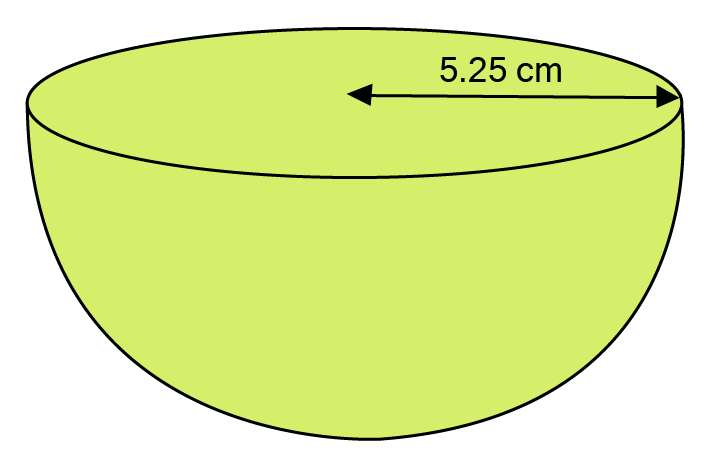
Ans: Radius of hemisphere
Total surface area of hemisphere
Hence total surface area of hemisphere is
23. Find the radius of a sphere whose surface area is
Ans: Surface area of sphere
24. A hemispherical bowl is made of steel,
Ans: Inner radius of bowl
Thickness of steel
25. A right circular cylinder just encloses a sphere of radius
Find:
(i) Surface area of the sphere.
Ans: Radius of sphere
(ii) Curved surface area of the cylinder.
Ans: The cylinder just encloses the sphere in it.
And The radius of cylinder will be equal to radius of sphere.
(iii) Ratio of the areas obtained in (i) and (ii).
Ans:
26. A matchbox
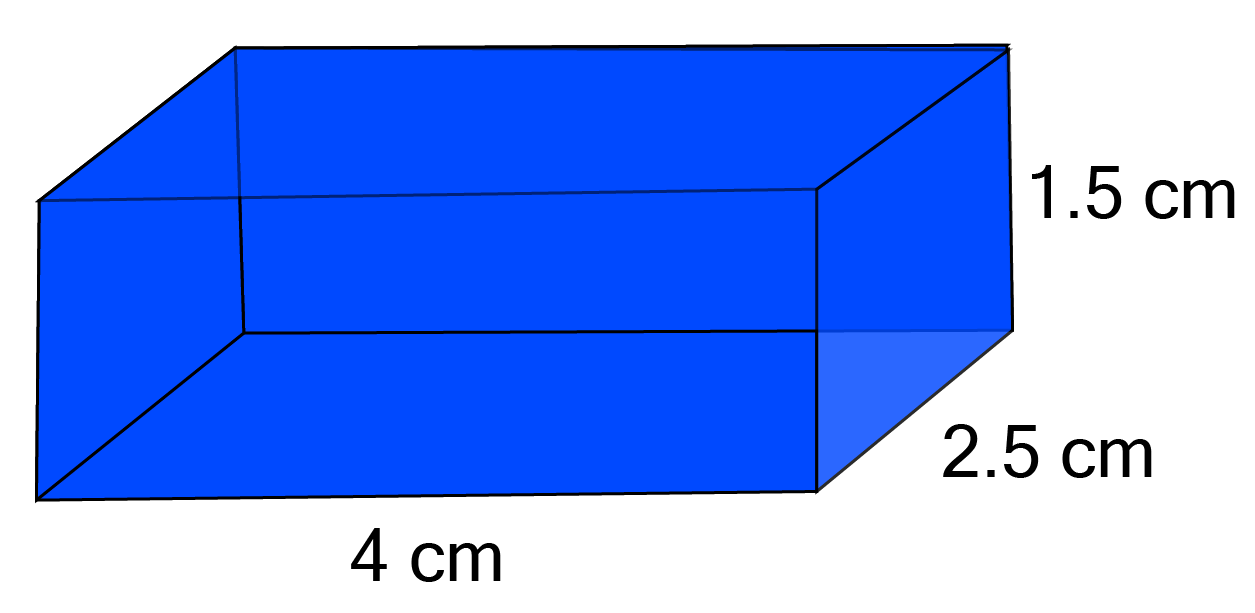
Ans: Given: Length
Breadth
Height
Volume of a matchbox
27. A cubical water tank is
Ans: Here
So, the cuboidal water tank can hold
28. A cuboidal vessel is
Ans: Let height of cuboidal vessel
Length
Breadth
Volume of liquid in cuboidal vessel
Hence cuboidal vessel is
29. Find the cost of digging a cuboidal pit
Ans: Here,
Volume of the cuboidal pit
Cost of digging
Cost of digging
Cost of digging the pit is
30. The capacity of a cuboidal tank is
Ans:
Let Breadth be b m
Capacity of cuboidal
Hence breadth of cuboidal tank is
31. A river 3 m deep and
Ans: Water flowing in river in 1 hour =
Water flowing in river in 1 hour
Water flowing in river in 60 minutes
Water flowing in river in 1 minute
Now,
River is in shape of cuboid
Volume of water falling in the sea in 1 minute
32. Find the length of a wooden plank of width
Ans: Given: Volume of wooden plank
Hence required length of wooden plank is
33. If the lateral surface of a cylinder is
Ans: Let radius of cylinder
Height
Now it is given that
Lateral surface
Curved surface area of cylinder
(ii) volume of the cylinder.
Ans:
Volume of cylinder
34. A bag of grain contains
Ans: Given
Volume of grain inside the bag
Radius of the drum
Height of the drum
The number of bag full of grains required
Hence
35. A lead pencil consists of a cylinder of wood with a solid cylinder of graphite filled in the interior. The diameter of the pencil is
Ans: Diameter of graphite
Volume of graphite
Diameter of pencil =
Volume of pencil
Now, Volume of wood = Volume of pencil
36. A patient in a hospital is given soup daily in a cylindrical bowl of diameter
Ans: Soup is in form of cylinder with
Volume of the soup in cylindrical bow
Soup served to 1 patient
Soup served to 250 patients
37. Find the volume of the right circular cone with:
(i) Radius
Ans: Given:
Volume of cone
(ii) Radius
Ans: Given:
Volume of cone
38. The height of a cone is
Ans: Height of cone
Let radius of cone
Given
Volume of cone
Hence required radius of the base is
39. If the volume of a right circular cone of height
Ans: Height of the cone
Let radius of cone
Given Volume of cone
40. A conical pit of top diameter
Ans: Height of conical pit
Radius of conical pit
Since
Capacity of pit
41. A right triangle ABC with sides
Ans: When right angled triangle
In that cone, Height
And radius
Therefore, Volume of cone
42.Find the volume of the largest right circular cone that can be fitted in a cube whose edge is
Ans: For largest circular cone radius of the base of the cone
And height of the cone
Volume of cone
43. Find the volume of a sphere whose radius is
(i)
Ans: Radius of sphere
Volume of sphere
(ii)
Ans: Radius of sphere
44. Find the amount of water displaced by a solid spherical ball of diameter:
(i)
Ans: Diameter of spherical ball =
According to question, Volume of water replaced = Volume of spherical ball
(ii)
Ans: Diameter of spherical ball
According to question,
Volume of water replaced = Volume of spherical ball
45. The diameter of a metallic ball is
Ans: Diameter of metallic ball
Volume of metallic ball
Density of metal
Mass of
46. A hemispherical tank is made up of an iron sheet
Ans: Inner radius
Volume of iron used
Volume of iron of hemisphere
47. A dome of a building is in the form of a hemisphere. From inside, it was whitewashed at the cost of Rs.
(i) the inner surface area of the dome.
Ans: Cost of white washing from inside
Rate of white washing
Area white washed
Therefore, inner surface area of dome
(ii) the volume of the air inside the dome.
Ans: Volume of air inside dome = Volume of hemisphere
Let the radius of dome
First we find radius using surface area
Surface area of dome
Volume of the air inside the dome
48. Twenty-seven solid iron spheres, each of radius
(i) radius
Ans: Volume of 1 sphere,
Volume of
Let
Volume of new sphere
(ii) ratio of
Ans:
49. A capsule of medicine is in the shape of a sphere of diameter
Ans: Diameter of spherical capsule =
Medicine needed to fill the capsule = Volume of sphere
50. Sameera wants to celebrate the fifth birthday of her daughter with a party. She bought thick paper to make the conical party caps. Each cap is to have a base diameter of
Ans: Diameter of base of conical cap =
Slant height of cone
Curved surface area of a cap
Curved surface area of a cap
Curved surface area of 15 caps
Area of a sheet of paper used for making caps
Number of sheet
Hence
51. Curved surface area of a right circular cylinder is
Ans: Let the height of the circular cylinder be
Radius
Curved Surface Area of cylinder
Therefore, the height of the cylinder is
52. The circumference of the trunk of a tree (cylindrical), is
Ans: Let
Circumference of the trunk
Converting dm into
The circumference is
The height is
The volume of the cylinder is
Therefore, the volume of the trunk is
53. If the areas of three adjacent faces of a cuboids are
Ans: Areas of three faces of cuboid as
So, Let length of cuboid be
Breadth of cuboid be
Height of cuboid be
Let,
Else write as
If '
Hence proved.
54. Find the volume of an iron bar has in the shape of cuboids whose length, breadth and height measure
Ans: Length of the bar
Breadth of the bar
Height of the
Weight of the bar
55. A rectangular piece of paper is
Ans: It is clear that circumference of the base of the cylinder = length of the paper Let
Volume of the cylinder
56. If the radius of the base of a right circular cylinder is halved, keeping the height same, find the ratio of the volume of the reduced cylinder to that of original cylinder.
Ans: Let the radius of the original cylinder
Height of the original cylinder
Radius of the reduced cylinder
Height of the reduced cylinder
From (i) and (ii) we get
Thus, there required ratio
57. A rectangle tank measuring
Ans: Volume of the tank
Area of the field
58. A village having a population of
Ans: Number of days water will last
Here,
Volume of the tank
Water required per person per day
Water required for 4000 person per day
Thus, the water will last for
59. Find the curved surface area of a right circular cone whose slant height is
Ans: Curved surface area
60. Find (i) the curved surface area
Ans: The curved
(ii) Total surface area of a hemisphere of radius
Ans: The total surface area of the hemisphere
61. The circumference of the base of a cylindrical vessel is
Ans: Given circumference of base of cylindrical vessel
Number of liters of water
Vessel can hold
62. A cubical box has each edge
Ans: Side of cubical box
Lateral surface area of cube
Length of cuboidal box
Breadth
Height
Lateral surface area
Lateral surface area of cuboidal box is greater by
63. A hemi spherical bowl has a radius of
Ans: The volume of water the bowl contain
Radius of hemisphere
The volume of water the bowl can contain
64. A conical pit of top diameter
Ans: Diameter of conical Pit
Height of conical pit
Radius of conical pit
Capacity of pit
Capacity of pit
65. The diagonals of a cube is
Ans: Let side of cube be a cm
Volume of cube
66. A cylindrical tank has a capacity of
Ans: Diameter of the base =
Radius
Hence depth of tank
67. Find the volume of a sphere whose surface area is
Ans: Given surface area of sphere
Let radius of the sphere
Volume of sphere
68. If the volume of a right circular cone of height
Ans: Given volume of cone
Volume of cone
Thus, the diameter of the base of cone is
69. The volume of a cylinder is
Ans: Volume
70. The volume of a cube is
Ans: Volume
Total surface area
3 Marks Questions:
1. A small indoor green house (herbarium) is made entirely of glass panes (including base) held together with tape. It is
(i) What is the surface area of the glass?
Ans: Length
Breadth
Height
The green house is cuboid and Glass is on the all 6 sides of cuboid greenhouse
Area of glass = Surface area of green house
Hence
(ii) How much of tape is needed for all the 12 edges?
Ans: Tape is used at
Hence
2. A metal pipe is
(i) Inner curved surface area
Ans:
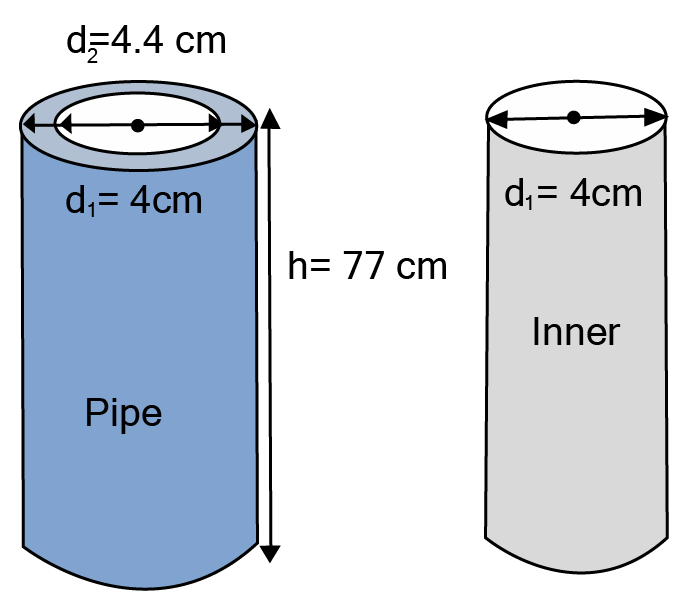
Inner diameter of cross-section
Inner radius of cylindrical pipe
Height
Curved Surface Area of inner surface of pipe
Inner curved surface area is
(ii) Outer curved surface area
Ans: Outer diameter of pipe
Outer radius of cylindrical pipe
Height of cylinder
Curved Surface Area of outer surface of pipe
Outer curved surface area is
(iii) Total surface area
Ans:
Total surface area
Total surface area = Curved Surface Area of inner cylinder
Therefore, the total surface area of the cylindrical pipe is
3. Curved surface area of a cone is
(i) radius of the base
Ans: Slant height of cone
Curved surface area of cone
Therefore, the radius of the circular end of the cone is
(ii) total surface area of the cone.
Ans: Total surface area of the cone = Curved surface area + Area of circular base
Therefore, the total surface area of the cone is
4. A conical tent is
(i) slant height of the tent.
Ans: Height of the conical tent
Radius of the conical tent
Let the slant height of the tent be
Slant height of the tent
Therefore, the slant height of the tent is
(ii) cost of the canvas required to make the tent, if the cost of a
Ans: Here the tent does not cover the base, So, find curved surface area of tent Curved surface area of tent
Here,
Curved surface area of tent
Cost of
Cost of
Therefore, the cost of the canvas required to make the tent is
5. What length of tarpaulin
Ans: Height of the conical tent
Slant height of the tent
Area of tarpaulin
Width of tarpaulin
Let Length of
Now, According to question,
The extra length of the material required for stitching margins and cutting is
So, the total length of tarpaulin bought is
6. A bus stop is barricaded from the remaining part of the road, by using 50 hollow cones made of recycled cardboard. Each cone has a base diameter of
Ans: Curved surface area of cone will be painted
and let 1 be the slant height,
Cost of painting
7. The radius of a spherical balloon increases from
Ans: I case: Radius of balloon
Surface area of balloon
II case: Radius of balloon (R) =
Surface area of balloon
Now, Ratio [from eq. (i) and (ii)],
Hence, required ratio
8. A village having a population of
Ans: Capacity of cuboidal tank
Water required by her head per day
Water required by 4000 persons per day
Number of days the water will last
Hence water of the given tank will last for
9. A godown measures
Ans: Capacity of cuboidal godown
Capacity of wooden crate
Maximum number of crates that can be stored in the godown
Hence maximum
10. Find the minimum number of bricks each measuring
Ans: Volume of one cuboidal brick
Volume of cuboidal wall
11. The circumference of the base of a cylindrical vessel is
Ans: Height of vessel
Circumference of base of vessel =
Now, Volume of cylindrical vessel
12. The inner diameter of a cylindrical wooden pipe is
Ans: Inner diameter of pipe
And Outer diameter of pipe
Length of pipe
Volume of wood
Therefore, mass of pipe is
13. A soft drink is available in two packs (i) a tin can with a rectangular base of length
Ans: Given, Length
Width
Height
Volume of the tin can
(ii) a plastic cylinder with circular base of diameter
Ans: Given, Diameter
Hence, Cylinder container has greater capacity by
14. It costs
(i) inner curved surface area of the vessel.
Ans: Total cost to paint inner curved surface area of the vessel
Rate
Inner curved surface area of vessel
(ii) radius of the base.
Ans: Depth of the vessel
Now, Inner surface area of vessel
(iii) capacity of the vessel.
Ans: Since
15. The capacity of a closed cylindrical vessel of height
Ans: Height of the vessel
Capacity of vessel
16. Find the capacity of a conical vessel with:
(i) Radius
Ans: Given:
Capacity of conical vessel
(ii) Height
Ans: Given:
Capacity of conical vessel
17. If the triangle ABC in question 7 above is revolved about the side
Ans: When right angled triangle
In that cone, Height
And radius
Therefore, Volume of cone
Now,
18. The diameter of the moon is approximately one-fourth the diameter of the earth. What fraction is the volume of the moon of the volume of the earth?
Ans: Let diameter of earth be
Now, Volume of earth
According to question,
Diameter of moon
Radius of moon
Now, Volume of Moon
Volume of moon is
19. How many litres of milk can a hemispherical bowl of diameter
Ans: Diameter of hemispherical bowl =
Volume of milk in hemispherical bowl
20. Find the volume of a sphere whose surface area is
Ans: Surface area of sphere
Now, Volume of sphere
21. A wooden bookshelf has external dimensions as follows: Height
Ans: External faces to be polished
Now, cost of painting outer faces of wodden bookshelf at the rate of
Here, three equal five sides inner faces.
Therefore, total surface area
Now, cost of painting inner faces at the rate of 10 paise i.e. Rs.
22. If diameter of a sphere is decreased by
Ans: Diameter of original sphere
Curved surface area of original sphere
According to the question, Decreased diameter
Now, curved surface area of new sphere
Change in curved surface area
Percent change in the curved surface area
23. The surface area of cuboids is
Ans: Let the dimensions of the cuboid be
Surface area of the cuboid
Given surface area
From (i) and (ii) we get
or
or
Thus, the dimensions of the cuboid are
24. The volume of a rectangular slower of stone is
Ans: Let the length of the block be
Width
Volume of the block
or
also
Thus, dimensions of the block are
Surface area of the block
Cost of polishing the surface
25. In a cylindrical drum of radius
Ans: Radius of the drum
Height of the drum
Volume of wheat in each bags
Hence the number of full bags is
26. The inner diameter of a cylindrical wooden tripe is
Ans: Inside diameter of the pipe
Outside diameter of the pipe
Length of the pipe
Outside radius of the pipe
Mass of
27. A patient in a hospital is given soup daily in a cylindrical bowl of a diameter
Ans: Diameter of the bowl
Radius of the bowl
Height up to which soup is filled
Volume of the soup in one bowl
Soup given to 250 patients
Hence the hospital has to prepare
28. The diameter of a roller is
(a) Find the area of playground in sq
Ans:
Area
Area covered in the revolution
Thus, area of playground
(b) Determine the cost of leveling the playground at the rate of Rs
Ans: cost of leveling 1 sq
Cost of total leveling
29. A metal cube of edge
Ans: Volume of cube with edge
Volume of the first smaller cube with edge
Volume of the second smaller cube with edge
Let the edge of the third smaller cube be a
By the given condition.
area
Area
Thus, the edge of the third required cube is
30. How many bricks, each measuring
Ans: Length of the wall
Width of the wall
Height of the wall
Volume occupied by master
Volume of a brick
cost of 1000 bricks = Rs 1100
Total cost
31. A river
Ans: Depth of river
Water of the river
Rate of flow of water
Hence, Volume of water flowing in one minute
32. If the lateral surface of a cylinder is
(i) radius of its base
Ans: Given lateral surface of cylinder
(ii) its volume
Ans: Volume of cylinder
33. A shot put is a metallic sphere of radius
Ans: Volume of sphere
Mass of
34. The capacity of a hemispherical tank is
Ans: Capacity of tank
Hence radius of tank
35. What length of tarpaulin
Ans: Here
Curved surface area
Length of tarpaulin required
Extra length required for wastage
Hence, total length required
36. A capsule of medicine is in the shape of a sphere of diameter
Ans: Given radius of capsule
37. A wall of length
Ans: Length of wall
Thickness
Height
Volume of wall
Now each brick is a cuboid with length
Breadth
Volume of each brick
Number of bricks required
The wall requires
38. The pillars of a temple are cylindrically shaped if each pillar has a circular base of radius
Ans: Radius of base of cylinder
Height of pillar
Volume of each cylinder
So,
39. A right triangle ABC with sides
Ans: The solid obtained by revolving the given right triangle is a right circular cone with radius
And height
40. The inner diameter of a circular well is
(i) Its inner curved surface area.
Ans: Given Inner diameter of well
(i)
(ii) the cost of plastering this curved surface at the rate of Rs 40 per
Ans: The cost of plastering is Rs 40 per
41. A Godown measures
Ans: Dimensions of Godown
Volume of Godown
volume of wooden carts
No. of wooden crates
Hence,
42. The volume of a right circular cylinder is
Ans: Volume of cylinder
Volume of cylinder
4 Marks Questions:
1. Shanti Sweets Stall was placing an order for making cardboard boxes for packing
their sweets. Two sizes of boxes were required. The bigger of dimensions
surface area is required extra, for all the overlaps. If the cost of the cardboard is
for
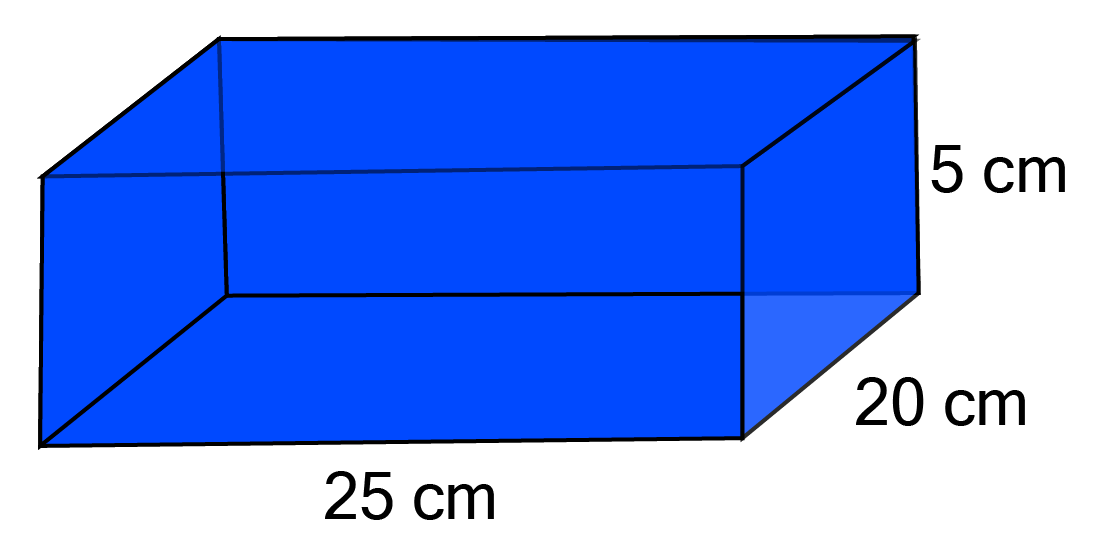
Ans: Given, Length of bigger cardboard box
Breadth
Total surface area of bigger cardboard box
Substitute values
Now, total surface area of bigger cardboard box with extra overlaps
Since, Cost of the cardboard for
Now, Cost of the cardboard for
Cost of the cardboard for
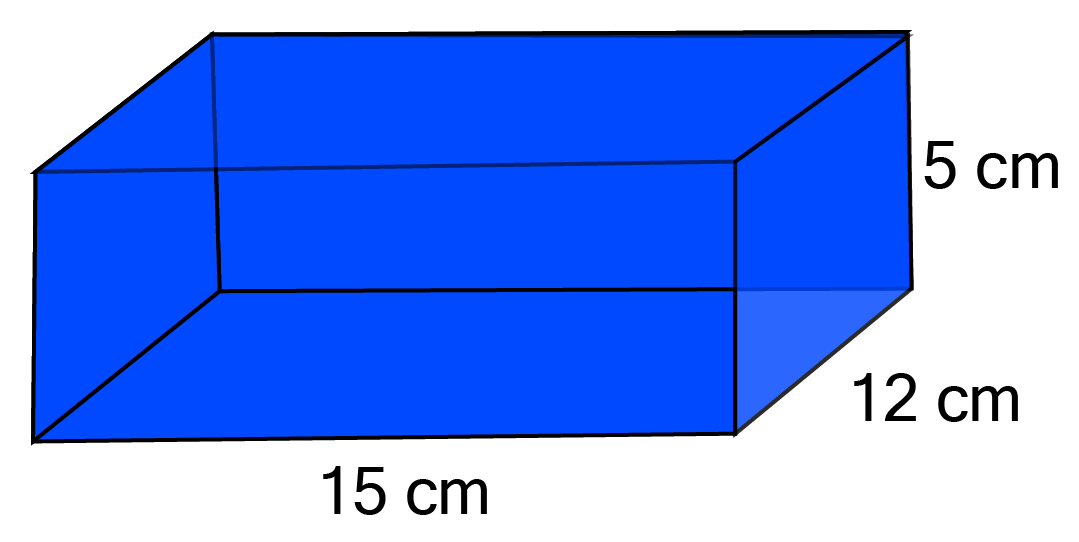
Now length of the smaller box
Breadth
Total surface area of the smaller cardboard box
Substitute values
Thus,
Total surface area with extra overlaps
Now Total surface area with extra overlaps of
Cost of the cardboard for
Cost of the cardboard for
Cost of the cardboard for
Therefore, Total cost of the cardboard required for supplying
2. Find
(i) the lateral or curved surface area of a petrol storage tank that is
and
Ans: Diameter of cylindrical petrol tank
Thus, Radius of the cylindrical petrol tank
And Height of the
Therefore, Curved surface area of the cylindrical tank
(ii) how much steel was actually used if
Ans: Let the actual area of steel used be
Since
Hence, the steel actually used is
3. A hemispherical bowl made of brass has inner diameter
tinplating it on the inside at the rate of Rs.
Ans: Inner diameter of bowl
Thus, Inner radius of bowl
Now, Inner surface area of bowl
Then, Cost of tin-plating per
Therefore, Cost of tin-plating per
4. The diameter of the moon is approximately one fourth the diameter of the earth.
Find the ratio of their surface areas.
Ans: Let diameter of Earth
Thus, Radius of Earth
Surface area of Earth

Now, Diameter of Moon
Thus, Radius of
Surface area of Moon
Now, Ratio
Therefore, Required ratio
5. A solid cube of side
side of the new cube? Also, find the ratio between their surface areas.
Ans: Volume of solid cube
Volume of each new cube
Side of new cube
Now, Surface area of original solid cube
Now, Surface area of original solid cube
Now according to the question,
Hence, required ration between surface area of original cube to that of new cube
6. The volume of a right circular cone is
find:
(i) Height of the cone
Ans: Diameter of cone
Radius of cone
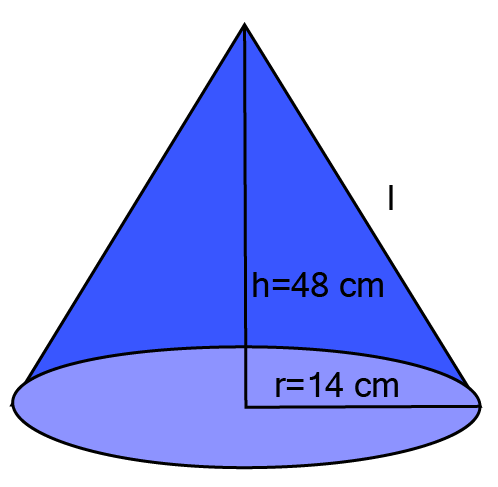
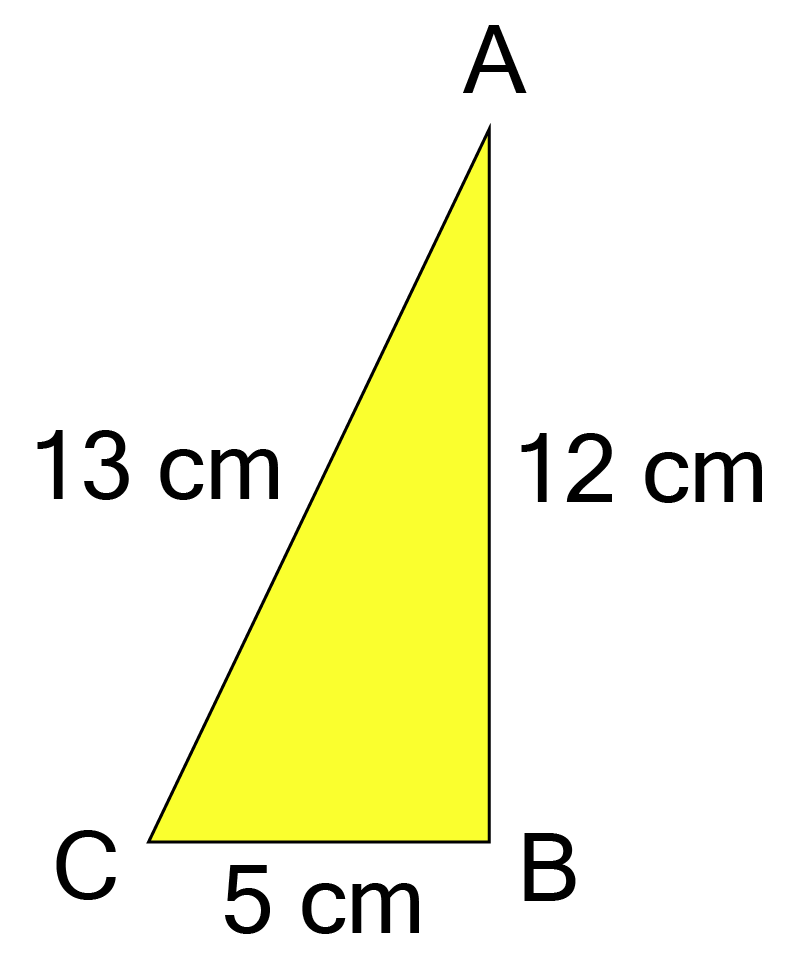

Volume of cone
(ii) Slant height of the cone
Ans: Slant height of cone
(iii) Curved surface area of the cone.
Ans: Curved surface area of cone
7. The front compound wall of a house is decorated by wooden spheres of diameter
this purpose and are to be painted silver. Each support is a cylinder of radius
and height
costs

Ans: Diameter of a wooden sphere
Then, Radius of wooden sphere
And Radius of the cylinder
Surface area of silver painted part = Surface area of sphere - Upper part of cylinder for
support
Substitute values
Surface area of such type of 8 spherical part
Since, Cost of silver paint over
Therefore, Cost of silver paint over
Now, curved surface area of a cylindrical support
Curved surface area of 8 such cylindrical supports
Since, Cost of black paint over
Therefore, Cost of black paint over
Therefore, Total cost of paint required = Rs.
8. The difference between outside and inside surface of a cylindrical metallic tripe
radius of the tripe.
Ans: Let
Area of the outside surface
Area of the inside surface
By the given condition
or
Or,
Again volume of the metal used in the pipe
or,
Divide
Or,
Also,
Adding
And,
Therefore,
Or,
Thus, outer radius
9. The ratio between the radius of the base and height of a cylinder is
total surface area of the cylinder if its volume is
Ans: Let the radius of the base of the cylinder be
Thus, Height of the cylinder
Volume of the cylinder
By the given condition
Thus, radius
And height
Total surface area
Thus total surface area of the cylinder is
10. Twenty-seven solid iron spheres, each of radius
form a sphere with surface area S' find the
(i) radius
Ans: Total volume of
Volume of each original sphere
Volume of
Volume of new sphere
Therefore,
(ii) ratio of
Ans: Surface area of original sphere
Surface area of new sphere
Therefore, Ratio of
11. Shanti sweets stall was placing an order for making cardboard boxes for packing
their sweets two sizes of boxes were required. The bigger of dimensions
smaller of dimensions
area is required extra. If the cost of cardboard is Rs
cardboard required for supplying
Ans: Given dimensions of bigger box
Total surface area of bigger box
Extra cardboard for packing
Cardboard used for making box
Dimensions of smaller box
Total surface area of smaller box
Extra cardboard for packing
Total area of cardboard
Total cardboard used for making
Cardboard used for making
Cost of cardboard
12. A hollow spherical shell is made of a metal of density
diameter of the shell is
(i) Volume of the metal contained in the shell
Ans: External diameter of the spherical shell=
External radius
Internal diameter
Internal radius
Volume of the metal
Substitute values
(ii) Weight of the shell.
Ans: Weight of the shell = Volume
(iii) Outer surface area of the shell.
Ans: Outer surface area
Topics Covered in Important Questions for Class 9 Maths Chapter 11
There are several topics which are covered in chapter 11, maths class 9 important questions. Given below, we have written down some of the important topics that students need to learn to answer the questions related to this chapter.
Cuboid
Students will be introduced to a new shape called cuboid in the surface area and volume class 9 important questions. A cuboid is a three-dimensional shape made by combining six rectangular faces, all of them being on the right angles. When it comes to finding out the cuboid's total surface area, it is the sum of the areas of all six sides with rectangular faces.
The cuboid's total surface area can be calculated by using the formula = 2(lb + bh + lh).
Lateral Surface Area of Cuboid
Lateral surface area is the sum of all the surface area of sides except the top and the bottom faces. The lateral surface area can be calculated by the following formula which is LSA (cuboid) = 2h(l + b)
Cube
A cube is just like a cuboid, but all the cube sides are of the same length. It is also a three-dimensional shape bounded by the six squares one at each of its face. The cube has 12 edges and a total of 8 vertices. The total surface area of the cube is written in the given formula with an explanation.
Total surface area(TSA) of the cube = 2(a × a + a × a + a × a)
TSA(cube) = 2 × (3a2) = 6a2.
Lateral Surface Area of The Cube
As we have already said earlier, it is the surface area of all the sides except the top and bottom. Thus, the cube's lateral surface area can be calculated by the following formula = 2(a × a + a × a) = 4a2.
Right Circular Cylinder
A right circular cylinder is said to be a cylinder with two parallel circular bases connected by a curved surface. In addition to this, these two bases are precisely aligned over each other, and their axis is at the right angles to the base.
The Curved Surface Area of A Right Circular Cylinder
To find out the cylinder's surface area, a student needs to get a cylinder with the base radius r and height h. When opened up along the diameter, the curved surface of a cylinder will have the diameter that is d = 2r of the circular base, and it will form a rectangle of a length 2πr with the height h. As a result, a cylinder's curved surface area with base radius r and height h will be 2π × r × h.
Total Surface Area of A Right Circular Cylinder
The cylinder's total surface area with the base (r) and height (h) = 2π × r × h + area of two circular bases.
TSA = 2π × r × h + 2 × πr2
TSA = 2πr(h + r)
Relationship Between The Slant Height And Height of A Right Circular Cone
With the Pythagoras theorem, we can find out the relationship between the slant height, which is denoted by (l), and height (h) of a right circular is l2= h2+r2.
Here r is the radius of the base of the given cone.
Surface Area and Volume Class 9 Important Questions for Exam Point of View
Now that we have cleared out the basics of chapter 11, it's time to give our students some questions to practice. You can find the solution to these questions if you have studied well and understood the topics correctly. Given below are a few questions which we would like you to attempt on your own and find out their answers.
Q1) How much of a chocolate ice-cream can be put into a single cone with the base radius of 3.5 cm and height 12 cm?
Q2) If we doubled the radius in a given cylinder and cut its height into half, then find out what will happen to its curved surface area?
Q3) The radii of two cylinders of the same height have the ratio 4:5 and then determine the ratio of their volumes for each other.
Q4) To make a closed cylindrical vessel of height 1 m and diameter 120 cm find out how much of the sheet is required to cover the cylinder vessel.
Q5) The curved surface area of a given ice-cream cone is 12 sq. cm, if the radius of its base is 4 cm, find out how much is the height of the cone?
Q6) A metallic sphere is said to be having the radius 5 cm. If the metal density is 7.5 g/cm2, find out the mass of the sphere (π = 22/7).
Q7) Find out the diameter of a cylinder with a height of 5 cm and the numerical value of its volume is equal to the numerical value of its curved surface area.
Q8) Calculate the paint required for the surface area of a hemispherical shaped dome of a temple with a radius of 14 m to be whitewashed from outside.
Q9) A right triangle XYZ with sides 10 cm, 24 cm and 26 cm is revolved around 10 cm. Find the volume of the solid so obtained. If it is now revolved around the side 24 cm, what would be the ratio of the two volumes of the two solids obtained for both cases?
Q10) Ishan provides water to his village, the village having a population of 5000 which requires 200 litres of water per head for each day. He has a storage tank with the measurements of 20 m × 15 m × 6 m. Find out for how many days the water present in his tank will last?
Tips to Learn Class 9 Maths Chapter 11 Surface Areas and Volumes
Before jumping into the formulas, make sure you know the basic shapes like cubes, cuboids, cylinders, and spheres. Visualizing them will make the calculations easier.
The key to mastering this chapter is memorizing and practising formulas like surface area and volume. Write them down and keep revising them until they become second nature.
Always draw a neat diagram of the solid you are working with. It helps you understand the dimensions and visualize the problem, making it easier to apply the right formula.
Relate the chapter to real-life objects like a juice can (cylinder) or a tennis ball (sphere). It will help you understand the practical application of the formulas.
Pay attention to the units of measurement in surface area and volume problems. Ensure that the units are consistent (like meters or centimetres) to avoid calculation errors.
Practice solving important questions from previous years. This will help you understand the types of problems asked and improve your speed and accuracy for exams.
Benefits of Class 9 Maths Chapter 11 Important Questions
It is not easy to prepare for the class 9th maths chapter 11 important question, but with Vedantu's solved question PDF, you can understand every concept more clearly and precisely. Given below, we have written some of the key benefits that the student receives when using our Pdf to find out the solution of an unsolved maths problem.
First, our teachers are experts in their subjects, so you find yourself to be stuck somewhere in your learning. Just open up the Pdf, and in a few minutes, all your doubts will be cleared.
Likewise, in mathematics, students need to perform a step by step solution for the given question. With the help of our solutions, students will know which steps are important and which ones they can skip while writing the answer thus, it will make things easier for the students in exams by saving their time.
In addition to this, a PDF can be opened anytime once it is downloaded offline. As a result, students can open up the Pdf straight from their hard drives or on their mobile devices without worrying about the internet connection.
Lastly, mathematics is one of the subjects where you need to practice more and more accurately with your answer and precise with your timing. With Vedantu's solved question, you will have more problems to solve for a given topic, increasing your confidence and helping you tackle multiple question types.
Conclusion
Vedantu’s Important Questions from Class 9 Maths Chapter 11 Surface Areas and Volumes is key to understanding how to calculate the areas and volumes of 3D shapes. With regular practice of these questions, you'll get a clear understanding of essential formulas and concepts. This chapter not only helps you solve problems accurately but also strengthens your foundation for future maths topics. So, focus on learning these important questions, apply the formulas, and practice solving different types of problems to improve your confidence and perform well in your exams!
Related Study Materials for Class 9 Maths Chapter 11 Surface Areas and Volumes
S.No | Study Materials for Class 9 Maths Chapter 11 |
1. | |
2. | |
3. | |
4. | CBSE Class 9 Maths Surface Areas and Volumes Important Formulas |
CBSE Class 9 Maths Chapter-wise Important Questions
S.No | Chapter-wise Important Questions for Class 9 Maths |
1. | |
2. | |
3. | |
4. | |
5. | |
6. | |
7. | |
8. | |
9. | |
10. | |
11. |
Related Important Links for Maths Class 9
Along with this, students can also download additional study materials provided by Vedantu for Maths Class 9–
S.No | Study Materials for Class 9 Maths |
1 | |
2 | |
3 | |
4 | |
5 | |
6 | |
7 | |
8 | |
9. |
FAQs on Surface Areas and Volumes Class 9 Important Questions: CBSE Maths Chapter 11
1. What are the important topics to study for CBSE Class 9 Chapter-13 Surface Areas and Volumes?
All important topics for CBSE Class 9 Chapter-13 Surface Areas and Volumes are available on Vedantu.
Here are some important topics to Study:
Cube
Cuboid
Right Circular Cylinder
Right Circular Cone
Sphere
Hemisphere
Hollow hemisphere.
2. The volumes of the two spheres are in the ratio 64:27. Find the ratio of their surface area.
The volume of the two spheres is in the ratio =
We know that
Volume of sphere
Then,
Then, the Ratio of areas in both spheres
Hence, this is the answer.
3. The radius of the cylinder whose lateral surface area is 704 cm2 and height of 8 cm is:
Curved surface area of a cylinder of radius “R” and height “h”
Hence, the Curved surface area of the cylinder
The radius of the base of the cylinder is 14 cm.
4. Where can I find the questions and formula for CBSE Class 9 chapter 11-Surface Areas and Volumes?
Surface Areas and Volumes is an important chapter for class 9 and it is highly visualized and practical in daily life. Complete organized questions and their detailed solutions are available on the Vedantu app. You can easily practice the previous year's questions and watch video lectures also.
5. If the edge of a cube is tripled, find the ratio of the surface areas of that of a volume of two cubes.
Let the edge of the cube be
So, the surface area of the cube is
Now, the edge of the cube is tripled that is
So, the surface area will be
Ratio of surface areas of both cubes
Ratio of their volumes



































